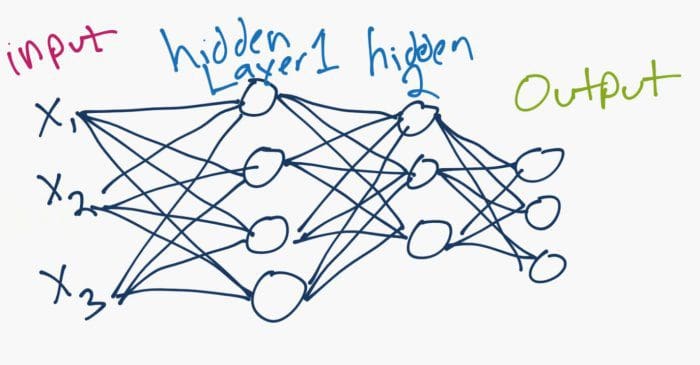 Deep Learning Papers Reading Roadmap
Deep Learning Papers Reading Roadmap
The roadmap is constructed in accordance with the following four guidelines: from outline to detail; from old to state-of-the-art; from generic to specific areas; focus on state-of-the-art.
By Flood Sung, Independent Deep Learning Researcher.

Source: pythonprogramming.net/neural-networks-machine-learning-tutorial
If you are a newcomer to the Deep Learning area, the first question you may have is "Which paper should I start reading from?"
Here is a reading roadmap of Deep Learning papers!
The roadmap is constructed in accordance with the following four guidelines:
- from outline to detail
- from old to state-of-the-art
- from generic to specific areas
- focus on state-of-the-art
You will find many papers that are quite new but really worth reading.
I would continue adding papers to this roadmap.
Editor: What follows is a portion of the papers from this list. Please see the original for the full listing of papers and categories.
1 Deep Learning History and Basics
1.0 Book
[0] Bengio, Yoshua, Ian J. Goodfellow, and Aaron Courville. "Deep learning." An MIT Press book. (2015). [pdf] (Deep Learning Bible, you can read this book while reading following papers.)
1.1 Survey
[1] LeCun, Yann, Yoshua Bengio, and Geoffrey Hinton. "Deep learning." Nature 521.7553 (2015): 436-444. [pdf] (Three Giants' Survey)
1.2 Deep Belief Network(DBN)(Milestone of Deep Learning Eve)
[2] Hinton, Geoffrey E., Simon Osindero, and Yee-Whye Teh. "A fast learning algorithm for deep belief nets." Neural computation 18.7 (2006): 1527-1554. [pdf](Deep Learning Eve)
[3] Hinton, Geoffrey E., and Ruslan R. Salakhutdinov. "Reducing the dimensionality of data with neural networks." Science 313.5786 (2006): 504-507. [pdf] (Milestone, Show the promise of deep learning)
1.3 ImageNet Evolution(Deep Learning broke out from here)
[4] Krizhevsky, Alex, Ilya Sutskever, and Geoffrey E. Hinton. "Imagenet classification with deep convolutional neural networks." Advances in neural information processing systems. 2012. [pdf] (AlexNet, Deep Learning Breakthrough)
[5] Simonyan, Karen, and Andrew Zisserman. "Very deep convolutional networks for large-scale image recognition." arXiv preprint arXiv:1409.1556 (2014). [pdf] (VGGNet,Neural Networks become very deep!)
[6] Szegedy, Christian, et al. "Going deeper with convolutions." Proceedings of the IEEE Conference on Computer Vision and Pattern Recognition. 2015. [pdf] (GoogLeNet)
[7] He, Kaiming, et al. "Deep residual learning for image recognition." arXiv preprint arXiv:1512.03385 (2015). [pdf](ResNet,Very very deep networks, CVPR best paper)
1.4 Speech Recognition Evolution
[8] Hinton, Geoffrey, et al. "Deep neural networks for acoustic modeling in speech recognition: The shared views of four research groups." IEEE Signal Processing Magazine 29.6 (2012): 82-97. [pdf] (Breakthrough in speech recognition)
[9] Graves, Alex, Abdel-rahman Mohamed, and Geoffrey Hinton. "Speech recognition with deep recurrent neural networks." 2013 IEEE international conference on acoustics, speech and signal processing. IEEE, 2013. [pdf] (RNN)
[10] Graves, Alex, and Navdeep Jaitly. "Towards End-To-End Speech Recognition with Recurrent Neural Networks." ICML. Vol. 14. 2014. [pdf]
[11] Sak, Haşim, et al. "Fast and accurate recurrent neural network acoustic models for speech recognition." arXiv preprint arXiv:1507.06947 (2015). [pdf] (Google Speech Recognition System)
[12] Amodei, Dario, et al. "Deep speech 2: End-to-end speech recognition in english and mandarin." arXiv preprint arXiv:1512.02595 (2015). [pdf] (Baidu Speech Recognition System)
[13] W. Xiong, J. Droppo, X. Huang, F. Seide, M. Seltzer, A. Stolcke, D. Yu, G. Zweig "Achieving Human Parity in Conversational Speech Recognition." arXiv preprint arXiv:1610.05256 (2016). [pdf] (State-of-the-art in speech recognition, Microsoft)
After reading above papers, you will have a basic understanding of the Deep Learning history, the basic architectures of Deep Learning model(including CNN, RNN, LSTM) and how deep learning can be applied to image and speech recognition issues. The following papers will take you in-depth understanding of the Deep Learning method, Deep Learning in different areas of application and the frontiers. I suggest that you can choose the following papers based on your interests and research direction.
Original. Reposted with permission.
Related:

 Deep Learning Papers Reading Roadmap
Deep Learning Papers Reading Roadmap